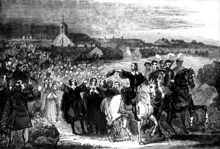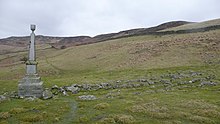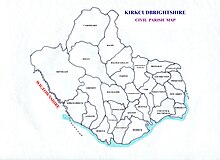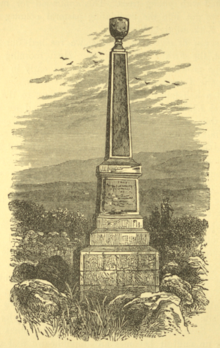John Michael Welsh of Irongray (c. 1624–1681) was a leader of the Scottish Covenanter movement. Dunlop, an early 20th century writer, says: "It is a noteworthy fact that there exists no memoir of John Welsh of Irongray, though from the Battle of Rullion Green till Bothwell Bridge he was the most conspicuous Covenanting minister in Scotland. Had he glorified God in the Grassmarket, or fallen in some scuffle with Claverhouse's dragoons, or even like his friend Blackadder of Troqueer languished in prison on the Bass Rock, some pious hand would have been moved to write his story."[4] Dunlop also wrote: "The events of Welsh's life must be sought for in the pages of Wodrow and Kirkton and in the letters and State papers of the reign of Charles II. After spending a fortnight hunting him in the British Museum, I have come to sympathise with Clavers and his dragoons. Mr John Welsh is a most elusive gentleman."[5]
John Welsh | |
|---|---|
 etching of Mr. Welch baptising children | |
| Church | Church of Scotland |
| Personal details | |
| Born | c. 1624 |
| Died | 9 January 1681 London |
| Buried | St. Botolph, Bishopsgate City of London |
| Nationality | Scottish |
| Denomination | Presbyterian |
| Occupation | minister |
| Alma mater | University of Glasgow |








Early life and ministry
editJohn Welsh was born, probably in 1624, son of Josias Welsh,[6] minister at Templepatrick, County Antrim, grandson of John Welsh of Ayr, and great-grandson of John Knox. He graduated with an M.A. from Glasgow University in 1647, and was admitted to Irongray on the Cluden Water, Dumfrieshire, on 21 January 1653.[7] At the instance of a heritor, David M'Brear of Newark and Almagill, M.P. for the Stewartry of Kirkcudbright, he was accused before the Privy Council, June 1662, of having called Middleton's Parliament "a drunken Parliament", but was acquitted since the witnesses' testimony did not agree.[8] Soon after the restoration of Episcopacy he was deprived. His congregation used force to prevent a new minister being settled.[9] The Privy Council imposed their will with increased force.[10] It was probably in February, 1663, that John Welsh was outed from Irongray. He seems to have sought refuge with John Neilson of Corsack, where other outed preachers, Gabriel Semple of Kirkpatrick-Durham and Blackadder of Troqueer also found shelter. Ejected ministers were forbidden to reside within twenty miles of their parishes, six miles of Edinburgh or any cathedral church, or three miles of any royal burgh. "Conditions which," as Wodrow remarks, " the nicest geographer would find hard to satisfy." They were pretty nearly satisfied in Welsh's case. At Corsack Welsh's first wife died. (Wodrow ii., 4, 5, 6, Veitch's Memoirs, Blackadder 24.) It was probably too at Corsack that Welsh penned his pamphlet, " Fifty and Two Directions to Irongray."[11]
Field preaching and Rullion Green
editWelsh was among the first who decided to preach in the fields against law, indeed, he is credited with being the inventor of the field conventicles of the Covenanters. In January, 1666, he was proclaimed for this, along with Semple and Blackadder, by the Privy Council. "Particularly the said Mr John Welsh does presume frequently, at least once every week, to preach in the parish of Irongray in the Presbytery of Dumfries, and himself and those who frequent his conventicles do convene together armed with swords and pistols; at which meetings he also baptizes children which are brought to him by disaffected persons."[12][13]
He is recorded as giving communion to between 3000 and 6000 people along with John Blackadder at Bishop's Forest, Irongray.[14] There is a monument and Communion Stones at Skeoch Hill.
He was probably the first of the field-preachers; was concerned in the Pentland Rising, and fled before Dalyell's troopers at Rullion Green.[15] Welsh was at the battle, and left it with the insurgent leader, Colonel Wallace. Whether he fled with Wallace to Holland is not known, but for nearly two years we hear nothing about him. Two parishioners and namesakes of Welsh were present at the battle, Welsh of Skaar and Welsh of Cornlee. They were among those who were exempted from the indemnity after Pentland.[16]
A wanted man
editIn 1667 he was hiding in a friend's house in Edinburgh, but soon afterwards he ventured into Clydesdale. Welsh may have found shelter in his own parish, but probably he was nearer his pursuers than they imagined; at any rate in 1668 he was lurking at the house of one Robert Grey in Edinburgh. (Kirkton, 1668.) Towards the end of the year he was preaching. The Earl of Tweeddale writes in November, 1668, to the Earl of Lauderdale that Mr John Welsh was running about Clydesdale and keeping conventicles both in houses and in the Church of Cambusnethan.[17][18]
In Fife
editHe preached in Fife to large crowds drawn from all classes. On one occasion, John Welsh preached to a large crowd at Kinkell, near St Andrews.
Philip Standfield, son of Sir James Standfield and a student at St Andrews University, attended the sermon and threw some missile that struck the preacher. Welsh said "I do not know who has put this public affront on Christ; but, be he who he may, there shall be more at his death than hearing me preach today". This turned out to be true, for the young man was later hanged for murdering his father.[19]
In Northern England
editRobert Traill spent much time with him. When in England he spent some time in Carlisle.[20] In August 1671 he was in Northumberland, where, says Wodrow, " he dwelt for some time very pleasantly."[21] He preached "when Tweed was frozen in the midst of the river, that either he might shun the offence of both nations, or that two kingdoms might dispute his crime."[22] In 1677 he dispensed the Communion at Skeochhill, in Irongray, where the "Communion Stones" are still pointed out. He was present at Drumclog and Bothwell Bridge.
Return to Scotland
editIn the spring of 1677 Welsh and other Covenanting preachers wece back in Scotland. With Blackader and Riddel he held a communion at Eckford in Teviotdale.[23][24]
In London
editAbout 1679 he went to London, where he died on 9 January 1681, and was buried in St Botulph Churchyard, Bishopsgate.[15] In a note of Miss Foxcroft to the supplement to Burnet's History (p. 103) it stated that he lived principally with Shaftesbury after Bothwell Bridge, and may thus have supplied Burnet with materials for his History.
His death caused no small stir in London. Lord Fountainhall mentions it in his Diary, adding : – "He was not so gross as to disown the King, as the Cameronians did: his grandfather, Mr John Welsh, was a great enemy of the bishops, and died in France." Wodrow, on the authority of a son of Hamilton of Kinkell, says that "Mr Welsh's burial was the greatest that for many years had been seen in London; that most of the Dissenters changed their text that Sabbath he was buried; that their congregations were invited to the burial, at which there was a vast number of ministers, persons of fashion, and, if my memory fails me not, some hundreds of coaches."[25]
Family life
editHe married his first wife at Holyrood, on 18 February 1653, Elizabeth Somerville, who died at Corsock. He then remarried in 1674, a lady whose name is unknown.[26]
Son: Edward Alexander Welsh md (married) Sarah Gaines: Grandson: Robert Alexander Welsh md Judith Barr: Great Grandson: John Robert Welsh md Anne Elizabeth Heggerty: 2nd Great Grandson: William Patrick Welsh md Johanna Cloughlan: 3rd Great Grandson Michael Patrick Welsh md Mary Ann Dunn.[citation needed]
Works
edit- A Preface, Lecture, and a Sermon (1686) ;
- Fifty and Two Directions . . . to his Paroch of Irongray (Edinburgh, 1703);
- A Sermon preached at Nemphlar Brae in Clidsdale (Edinburgh, 1703) ;
- An Alarm to the Impenitent (1710) ;
- The Great Gospel Sumonds to Close with Christ (Edinburgh, 1710) ;
- The Church's Paradox (n.d.) ;
- Two Sermons appear in Faithful Contendings Displayed, See also Sermons Delivered in Times of Persecution, and Simpson's Voice from the Desert[26]
Bibliography
edit- Memoirs of Blackader, 241 ;
- Wodrow's Hist., ii., 342, passim ;
- Treasury of the Scottish Covenant. 352 ;
- Transactions of the Dumfries and Galloway Natural History and Antiquarian Society, 1912-13[26]
References
editCitations
edit- ^ a b Thomson & Hutchison 1903.
- ^ Blackadder 1826, p. 98.
- ^ Map of Parishes in the Counties of Wigtown & Kircudbright, ScotlandsFamily
- ^ Dunlop 1912, p. 190.
- ^ Dunlop 1912, p. 191.
- ^ Howie & Carslaw 1870.
- ^ "Zoomable 25-inch OS map with tranparancy slider". National Library of Scotland. OS. Retrieved 3 August 2019.
- ^ Dunlop 1912, p. 194.
- ^ Dunlop 1912, p. 194-195.
- ^ Brown 1927, p. 357-359.
- ^ Dunlop 1912, p. 196.
- ^ Wodrow 1830, p. 4-5.
- ^ Dunlop 1912, p. 198.
- ^ Morton 1914.
- ^ a b Scott 1917, p. 287.
- ^ Dunlop 1912, p. 199.
- ^ Dunlop 1913, p. 68.
- ^ Maitland 1885a, p. 123.
- ^ Bruce 1884, p. 60.
- ^ Scott 1928, p. 474.
- ^ Wodrow 1830, p. 342.
- ^ Scott 1917, p. 287-288.
- ^ Blackadder 1826, p. 182ff.
- ^ Wodrow 1829, p. 347.
- ^ Wodrow 1843, p. 12-13.
- ^ a b c Scott 1917, p. 288.
Sources
edit- Aikman, James (1850). Annals of the persecution in Scotland, from the restoration to the revolution. Vol. 1 (2nd American ed.). Philadelphia: Presbyterian Board of Publications. Retrieved 19 July 2019.
- Barnett, T. Ratcliffe (1915). The makers of the kirk. London, Edinburgh, Boston: T. N. Foulis. pp. 201-216. Retrieved 31 July 2019.
- Blackadder, John (1826). Crichton, Andrew (ed.). Memoirs of Rev. John Blackader : compiled chiefly from unpublished manuscripts and memoirs of his life and ministry written by himself while prisoner on the Bass : and containing illustrations of the Episcopal persecution from the restoration to the death of Charles II : with an appendix giving a short account of the history and siege of the Bass & / by Andrew Crichton (2 ed.). Edinburgh: Printed for A. Constable & Company. This article incorporates text from this source, which is in the public domain.
- Blair, Robert (1754). Memoirs of the life of Mr. Robert Blair. Edinburgh: Printed by David Paterson.
- Blair, Robert (1848). M'Crie, Thomas (ed.). The life of Mr. Robert Blair, minister of St. Andrews, containing his autobiography, from 1593-1636 : with supplement of his life and continuation of the history of the times, to 1680. Edinburgh: Wodrow Society.
- Brown, P. Hume (1927). The register of the Privy Council of Scotland (1661–1664). 3. Vol. 1. To be purchased directly from H.M. Stationery Office at the following addresses 120, George Street, Edinburgh. pp. 357–359. Retrieved 7 April 2019.
- Bruce, George (1884). Wrecks and reminiscences of St. Andrews bay. John Leng & Co. p. 60.
- Dunlop, Samuel (1912). "John Welsh, the Irongray Covenanter". Transactions and Journal of Proceedings 1911-1912. 2. 24. Dumfries: Dumfriesshire and Galloway Natural History and Antiquarian Society: 190–200. Retrieved 5 August 2019. This article incorporates text from this source, which is in the public domain.
- Dunlop, Samuel (1913). "John Welsh, the Irongray Covenanter". Transactions and Journal of Proceedings 1912-1913. 3. 1. Dumfries: Dumfriesshire and Galloway Natural History and Antiquarian Society: 65-86. Retrieved 5 August 2019. This article incorporates text from this source, which is in the public domain.
- Gibson, James (1875c). Inscriptions on the tombstones and monuments erected in memory of the Covenanters; with historical introduction and notes. Glasgow: Dunn. pp. 239-242. Retrieved 13 April 2019.
- Hewison, James King (1913a). The Covenanters. Vol. 1 (Revised and Corrected ed.). Glasgow: John Smith and son.
- Hewison, James King (1913b). The Covenanters. Vol. 2. Glasgow: John Smith and son.
- Howie, John; Carslaw, W. H. (1870). "Josias Welch". The Scots worthies. Edinburgh: Oliphant, Anderson, & Ferrier. pp. 152-153.
- Johnston, John C (1887). Treasury of the Scottish covenant. Edinburgh: Andrew Elliot. p. 352. Retrieved 27 July 2019.
- Kirkton, James (1817). The secret and true history of the church of Scotland from the Restoration to the year 1678. Edinburgh: J. Ballantyne. pp. 16-23.
- Lewis, Samuel (1851). A topographical dictionary of Scotland, comprising the several counties, islands, cities, burgh and market towns, parishes, and principal villages, with historical and statistical descriptions: embellished with engravings of the seals and arms of the different burghs and universities. Vol. 2. London: S. Lewis and co. pp. 125-126. Retrieved 2 January 2018.
- Maitland, John (1884). Airy, Osmund (ed.). The Lauderdale Papers (1639–1667). Vol. 1. London: Camden Society. Retrieved 6 August 2019.
- Maitland, John (1885a). Airy, Osmund (ed.). The Lauderdale Papers (1667–1678). Vol. 2. London: Camden Society. Retrieved 6 August 2019.
- Maitland, John (1885b). Airy, Osmund (ed.). The Lauderdale Papers (1673–1679). Vol. 3. London: Camden Society. Retrieved 6 August 2019.
- McIntyre, Neil (2016). Saints and subverters : the later Covenanters in Scotland c.1648-1682 (PhD). University of Strathclyde. p. 127. Archived from the original on 28 July 2020. Retrieved 5 August 2019.
- M'Crie, Thomas (1875). The story of the Scottish church : from the Reformation to the Disruption. London: Blackie & Son. pp. 338-340.
- Morton, Alexander S. (1914). Galloway and the Covenanters; or, The struggle for religious liberty in the south-west of Scotland. Paisley : A. Gardner. pp. 389-398. Retrieved 16 April 2019.
- Morton, David (2013). Covenanters and Conventicles in South West Scotland (PDF) (MPhil(R)). University of Glasgow.
- Scott, Hew (1917). Fasti ecclesiae scoticanae; the succession of ministers in the Church of Scotland from the reformation. Vol. 2. Edinburgh: Oliver and Boyd. pp. 287-288. Retrieved 15 March 2019. This article incorporates text from this source, which is in the public domain.
- Scott, Hew (1928). Fasti ecclesiae scoticanae; the succession of ministers in the Church of Scotland from the reformation. Vol. 7. Edinburgh: Oliver and Boyd. p. 474. Retrieved 15 March 2019. This article incorporates text from this source, which is in the public domain.
- Smellie, Alexander (1903). "A Field Preacher". Men of the Covenant : the story of the Scottish church in the years of the Persecution (2 ed.). New York: Fleming H. Revell Co. pp. 249-264. Retrieved 11 July 2019.
- Smith, Philip Myles (2017). Yet the Fire Did Not Consume It: Religious Nonconformity and Presbyterian Resistance in the South and West of Scotland, 1661-1688 (PDF) (Masters). Harvard University.
- Thomson, J. H.; Hutchison, Matthew (1903). The martyr graves of Scotland. Edinburgh: Oliphant, Anderson & Ferrier. pp. 479-492. Retrieved 30 July 2019.
- Wodrow, Robert (1830). Burns, Robert (ed.). The history of the sufferings of the church of Scotland from the restoration to the revolution, with an original memoir of the author, extracts from his correspondence, and preliminary dissertation. Vol. 2. Glasgow: Blackie, Fullarton & co.; and Edinburgh: A. Fullarton & co.
- Wodrow, Robert (1829). Burns, Robert (ed.). The history of the sufferings of the church of Scotland from the restoration to the revolution, with an original memoir of the author, extracts from his correspondence, and preliminary dissertation. Vol. 3. Glasgow: Blackie, Fullarton & co., and Edinburgh: A. Fullarton & co. This article incorporates text from this source, which is in the public domain.
- Wodrow, Robert (1842). Leishman, Matthew (ed.). Analecta: or, Materials for a history of remarkable providences; mostly relating to Scotch ministers and Christians. Vol. 2. Glasgow: Maitland Club. pp. 58-59.
- Wodrow, Robert (1843). Leishman, Matthew (ed.). Analecta: or, Materials for a history of remarkable providences; mostly relating to Scotch ministers and Christians. Vol. 4. Glasgow: Maitland Club. pp. 12–13.